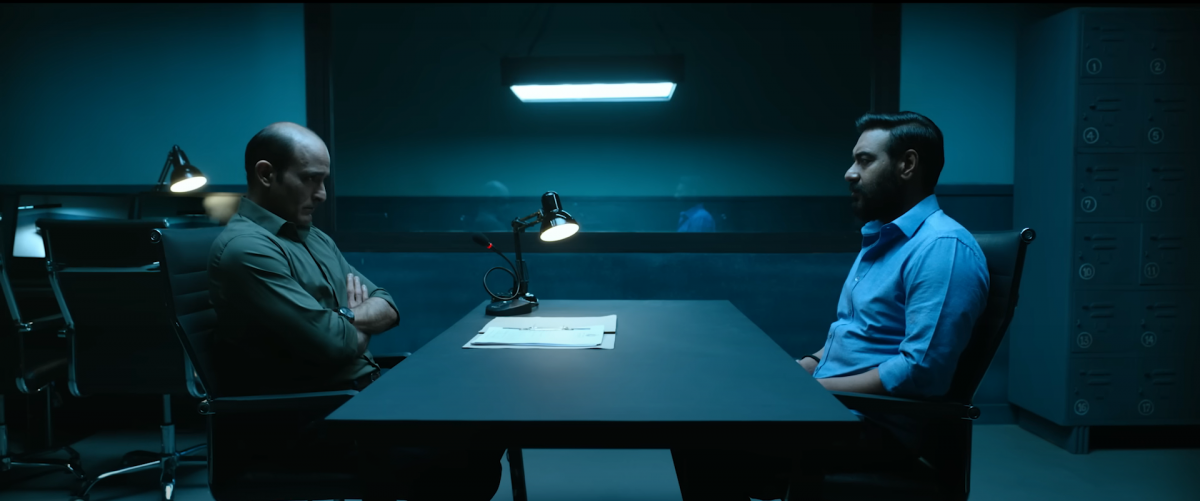Remakes reveal a fundamental truth about cinema: impressive films demand more than a compelling story. Drishyam 2, the Hindi release this week, is the maxim’s near-perfect illustration.
Jeethu Joseph wrote and directed both the original Malayalam versions. The sequel, Drishyam 2, which came out early last year, seemed like a rare breed: a follow-up trumping an acclaimed original. If Drishyam stomped an astounding climax, then Drishyam 2 coiled twists within twists; deceptions within deceptions; all justifying the hero’s preoccupation, ambition, and desperation – a cinephile reeling off a story.
Director Abhishek Pathak, helming the Hindi counterpart, couldn’t have dreamt of a better platform.
Set in 2021, Drishyam 2 opens seven years after its prequel. Vijay (Ajay Devgn), a cable TV business owner, now owns a multiplex. He’s also close to his ultimate dream: producing a movie. But his eternal nightmare – the cops investigating the death of a young man, killed by his daughter in self-defense – has snaked up on him, again, because the night Vijay buried the body, a fleeing murderer saw him.
Besides, the town has a new cool cat, inspector general Tarun (Akshaye Khanna), stoking the Tom and Jerry feud once more.
But right from the start, Drishyam 2 feels like an ‘old’ film. Not because it’s a remake but because of its devices. To build atmospheric tension, Pathak uses rainy nights. A lot. Sometimes, during the days, too. But it looks like forced garnish – or ‘dhaniya patta filmmaking’ – as opposed to an aesthetic choice belonging to the movie. This disconnect – between what the story demands and what the director delivers – mars the film.
Pathak doesn’t realise that a tense story doesn’t need more but less. So he keeps leaning on rusty crutches. It’s 2022, and we’ve seen them all. Scenes of ‘false tension’ where characters worry about something trivia; banging doors; knowing glances; innuendo-ridden threats; bland transition shots; a misplaced song; a dull song; and dialogues so pedestrian they compel Brahmastra to pop champagne corks. One of the best lines? “Film woh shuru karega, ending hum likhenge.”
The one original character, Tarun, produces a feast of clichés. Here’s how he’s introduced: playing chess with… himself. We hear his subordinate’s voice in the background: Tarun sir is “sanki yet genius”; “nobody knows what’s going on his mind”, and so on. But when the guy appears on screen, he doesn’t radiate those (clichéd) qualities as well.
What you get instead is an actor trying hard to be cool. Once upon a time, Khanna was cool – campy cool even. But in Drishyam 2, he produces an oxymoronic performance: someone straining to be subtle yet appearing cheesy; an embarrassing embodiment of purple prose.
Drishyam 2 and Khanna’s is a plug and socket relationship because the sloppiness runs deep. If a scene, for instance, carries a whiff of melodramatic potential, the background score descends on it like buzzing bees. Even Tabu is, at best, forgettable – a sentence I never thought I’d ever write.
The Drishyam universe is sly and subversive, but Pathak treats it like a dense academic paper, making it drone on. I craved small light moments. The movie gave me one full ‘joke’ – that too at the expense of Shriya Saran’s character. She doesn’t know the meaning of “demoralised”. I don’t know if that meta-sexism was intended but, either way, it’s quite embarrassing that such a scene is one of the (very) few examples of the director even trying.
Also read: ‘Drishyam 2’ Teases, Confounds and Eludes, but Above All, Keeps the Audience Riveted
Still, Drishyam 2 had some hope, as a lot pivots on the central character. An excellent conception, he’s everything you want in a protagonist: the hero, villain, puppet-master, con artist, sutradhar – everything. Mohanlal was superb as George Kutty. A guy so sedate he lulls the audiences into believing he’s harmless; a minimum man, a school dropout ‘nothing’ striving for something through cinema. Mohanlal plays him straight for the most part but, complementing the screenplay, he winks (just about enough) at the opportune moment, flooring you.
Devgn adopts Mohanlal’s gravitas but, like the Hindi movie, stays there. His performance is so flat it’s tedious to spend an entire film with him. Drishyam 2 keeps informing us who he is – a cinephile, a family man – but his actions speak softer than words.
The Joseph version teased out several ideas from the core of a thriller: the ‘little man’ dwarfing cops; cinema assuaging identity crises; a riveting story both charming and deceiving. The Pathak directorial has nothing. It doesn’t try; it can’t care. And that’s the difference between them: Joseph dives into his material, going deeper and deeper, scooping the world in the smallest details. Pathak ascends from his film, flying up and up, flailing and failing.
That said, if you haven’t seen the Joseph sequel, you may still like its Hindi counterpart, as the original features several delightful twists. But Pathak and his team deserve no credit for it. Because he’s accomplished the exact opposite of a good remake. The Malayalam film industry made a crime story; Bollywood made a grime story.
Featured image: A screengrab from the trailer of Drishyam 2 showing Akshaye Khanna (left) and Ajay Devgn. Photo: Youtube.
This article was first published on The Wire.

